There’s nothing quite like toothache pain to ruin your day. But what exactly causes this dreaded ailment?
Unfortunately, there are a number of possible culprits. One common cause of toothaches is inflammation of the pulp, which is the soft tissue inside the tooth. This can be caused by decay, infection, or trauma to the tooth.
Another potential cause is gum disease, which occurs when bacteria build up in the gums and cause inflammation. In some cases, a toothache may also be caused by clenching or grinding your teeth, which puts too much pressure on the teeth and surrounding tissues.
While you think about making a dental appointment, you could try homemade remedies like gargling warm salt water, a cold compress or OTC pain relievers.
In addition, Traditional Chinese Medicine can use firm pressure on key points to provide temporary pain relief, reduce inflammation, and promote healing.
To soothe your oral pain, first, you’ll need to know the acupoints for toothache due to inflammation.
Acupoint: LI-4 (Other Names: Large Intestine-4/He Gu/Joining Valley)

The acupressure point “LI-4”, is represented in mandarin as “He Gu” and in English as “Union Valley.” It is found on the dorsal hand between the thumb and pointer finger, on top of the mound formed when the thumb is pressed tightly on the finger between the first and second metacarpal bones. LI-4 is placed at the peak spot close to the thumb if the thumb and pointer finger are pressed together.
LI-4 expels wind and releases them outside, tones qi and improves immunity, relieves pain, controls the face and head area, and induces labor.
LI-4 is beneficial in providing acupressure for toothache due to inflammation and this was the acupoint used in a study involving maxillofacial surgery, where the points were chosen individually by selecting distal points and those that passed close to the surgery site.
Hold this acupoint between the thumb and index finger of the other hand and push it firmly about 30 times each.
Acupuncture was used before, during, and after surgery, and the authors concluded that acupuncture analgesia can be used in conjunction with conventional anesthesia in maxillofacial surgery.
Another study’s findings suggest that acupuncture analgesia at LI-4 could be a useful technological addition to pain treatment in patients with acute dental discomfort. LI-4 is also helpful in providing acupressure for heart related conditions.
Acupoint: LI-1 (Other Names: Large Intestine-1/Shang Yang/Metal Yang)
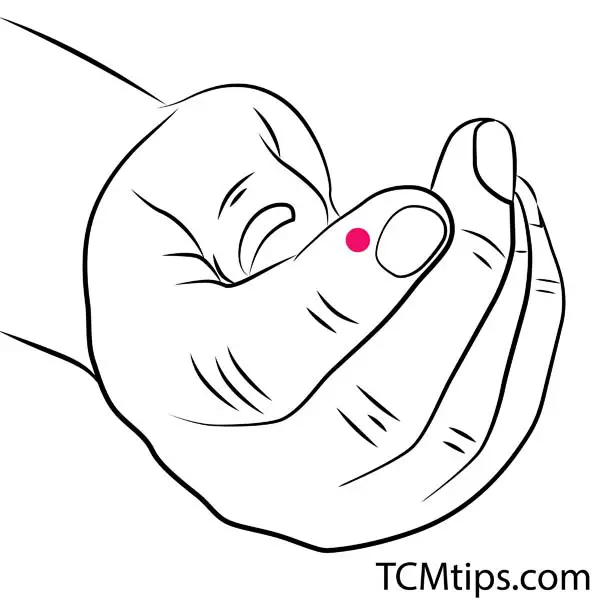
The acupressure point “LI-1”, is represented in mandarin as “Shang Yang” and in English as “Metal Yang.” It is found on the radial end of the index finger’s distal phalanx, 1cun (finger cun) distance from the nail’s corner.

It is classified as the Jing-Well point of the Large Intestine Meridian. Acupoint LI-1 is used to help revive people who have fainted, reduce fevers, and relax the lungs when people have a sore throat. It can also be useful for soothing the mind and alleviating allergy-related eye discomfort.
To use this acupoint, press and release repeatedly with moderate pressure. Alternatively, you can achieve the same effect by rubbing the index fingernail between the thumb and index finger of the opposite hand.
Since this acupoint helps in reducing the discomfort that is caused by a sore throat, it can be used as an acupressure point for gum swelling and can be beneficial for the radiated dental pain due to soreness in the throat. LI-1 also serves as one of the acupressure points for neck pain in the hands as well.
Acupoint: ST-6 (Other Names: Stomach-6/Jia Che/ Jaw Bone)
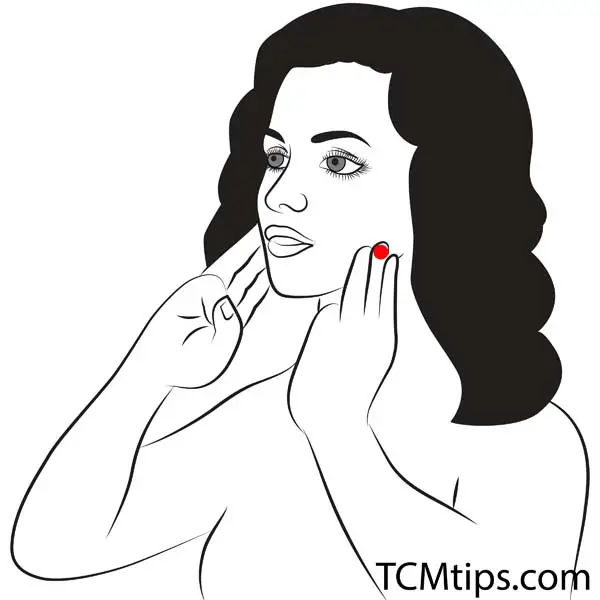
The acupressure point “ST-6”, is represented in mandarin as “Jia Che” and in English as “Jaw Bone.” It is found on the cheek, in the depression of one finger-breadth (middle finger) anterior and superior to the lower angle of the mandible where masseter muscle attaches, at the prominence of the muscle when the teeth are clenched.
The acupoint ST-6 is helpful in acupressure for toothache due to inflammation and dispels wind, clears meridian obstructions, relieves discomfort, and benefits the jaw and teeth. It is used to treat facial paralysis, facial nerve palsy, mumps, sore throats, cheek inflammation, dental pain, and facial spasms.
This acupoint is located along the stomach meridian and is associated with the relief of jaw pain, particularly toothaches. Because of its well-established modulation of stomach enzymes and acid, ST-6 is utilized to treat tooth problems.
Because this region is typically painful, apply gentle pressure for 1-2 minutes. When people clench their jaws or grind their teeth, the masseter muscle becomes rigid and tight. A little massage to this acupressure point might help relax the masseter muscles.
A 2019 study developed a dental pain model for acupuncture research and produced evidence that acupuncture can influence experimentally induced tooth pain at a few acupoints, including ST-6. It is also one of the acupressure points for swollen lymph nodes in the neck.
Acupoint: Ren-24 (Other Names: The Conception Vessel-24/Cheng Jiang/Saliva Container)
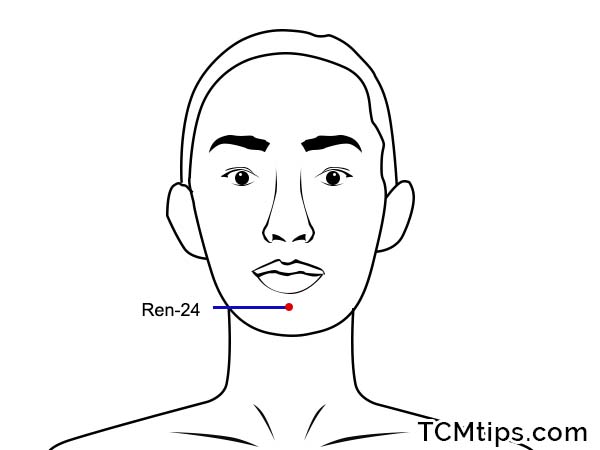
The acupressure point “Ren-24”, is represented in mandarin as “Cheng Jiang” and in English as “Saliva Container.” It is found on the region of the face, in the depression in the center of the mentolabial groove between the point of the chin and the lower lip.
It is classified as the Crossing point of the Ren Vessel and the Stomach Meridian. Acupoint Ren-24 is used in facial puffiness, gum inflammation, toothache, salivation, psychological illnesses, and eye and mouth deviation.
Apply sustained finger pressure to the acupoint about three times with firm to strong pressure. Do not rub or massage the entire region. Take long, calm, deep breaths and concentrate on the acupoint you’re working on. Hold the pressure for a few minutes until the soreness at the site subsides, then gradually remove the pressure.
A study investigated the use of acupuncture point Ren-24 in patients with severe gag reflexes who needed an alginate impression and discovered that 81% of the patients were able to accept impression taking. As a result, Ren-24 can be a viable alternative to traditional sedative treatments used to manage gagging during dental procedures. Other than being an important point to perform acupressure for toothache due to inflammation, Ren-24 is one of the valuable acupressure points on the face for glowing skin.
Acupoint: ST-7 (Other Names: Stomach-7/Xia Guan/Below the Arch)
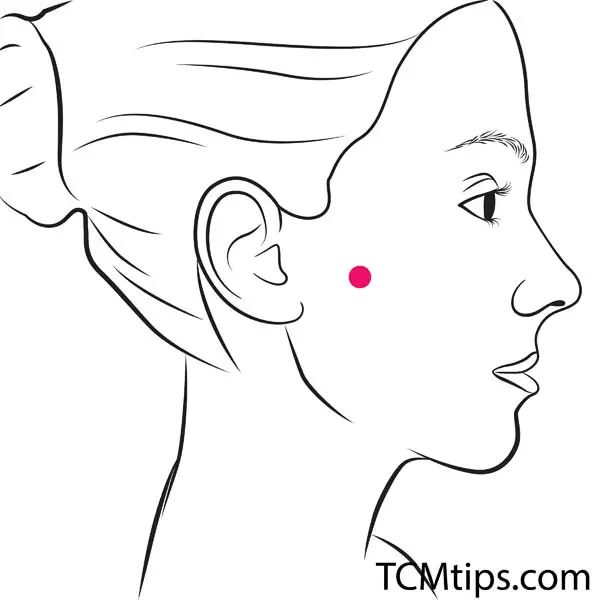
The acupressure point “ST-7”, is represented in mandarin as “Xia Guan” and in English as “Below the Arch.” It is found on the face, anterior to the ear, in the dip between the zygomatic arch and the mandibular condyloid process.
It is classified as the Crossing point of the Stomach and Gall Bladder Meridians. This point of acupressure for toothache due to inflammation clears obstructions in the meridian and benefits the ears, jaw, and teeth. It is used to treat:
– mouth pain
– lockjaw
– temporomandibular arthritis
– deafness, tinnitus
– tympanitis
– facial paralysis
– facial pain
– trigeminal neuralgia
– facial nerve palsy
– mandibular pain
– trigeminal neuralgia
The most basic technique is to apply firm pressure for 1-2 minutes to this point with your thumbs, fingers, palms, side of your hand, or knuckles. A common rule of thumb is that the pressure should be forceful enough to cause some discomfort. The greater the muscular development, the more pressure you should apply. If you experience acute sensitivity or pain, gradually reduce the pressure until you get a balance of discomfort and pleasure.
Acupuncture can be viewed as a viable alternative or adjunct to existing dental practice, both as an analgesic and for treating a variety of dental problems. A randomized controlled trial was conducted to investigate the effectiveness of acupuncture at various acupoints, one of which being ST-7, in patients with painful temporomandibular disorders. ST-7 is also one of the important acupressure points for skin tightening.
Acupoint: LI-7 (Other Names: Large Intestine-7/Wen Liu/Warm Flow)
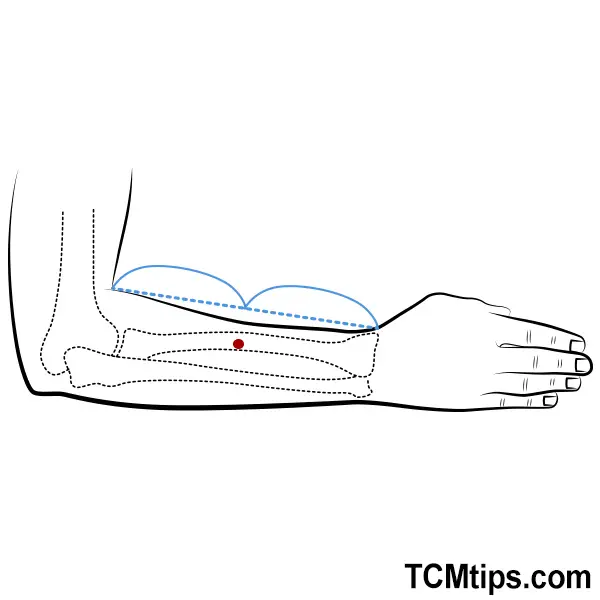
The acupressure point “LI-7”, is represented in mandarin as “Wen Liu” and in English as “Warm Flow.” It is found with the elbow flexed, the point is on the dorsal radial side of the forearm, 5 cun above the wrist crease, on the line connecting LI 5 and LI 11.
It is classified as the Xi-Cleft point of the Large Intestine Meridian. This acupoint clears heat and detoxifies, expels Wind, and benefits the throat. It is used in conditions such as headache, sharp tooth pain, facial swelling, sore throat, borborygmus, gastric pain, shoulder, and arm soreness.
Tooth and gum inflammation can cause severe facial swelling and nerve pain which can be relieved by using the acupoint LI-7. This acupoint is also beneficial for post-dental procedure headaches and sore throat. LI-7 is also one of the acupressure points for lower abdominal pain.

Try our Anti-Aging Gua Sha Tool designed to bring out your skin’s natural glow.
Best Gua Sha Product- Anti-Aging: The tool is designed to target 11 specific aging signs such as wrinkles and sagging skin. By following the 7-step routine, users can improve skin firmness and reduce fine lines naturally.
- Enhances Skincare Routine: It works effectively with serums and lotions, boosting absorption and efficacy of skincare products.
- Visible Skin Improvement: Users can expect a smoother complexion, reduced puffiness, and a more youthful appearance.
 P. Sze
P. Sze 

















